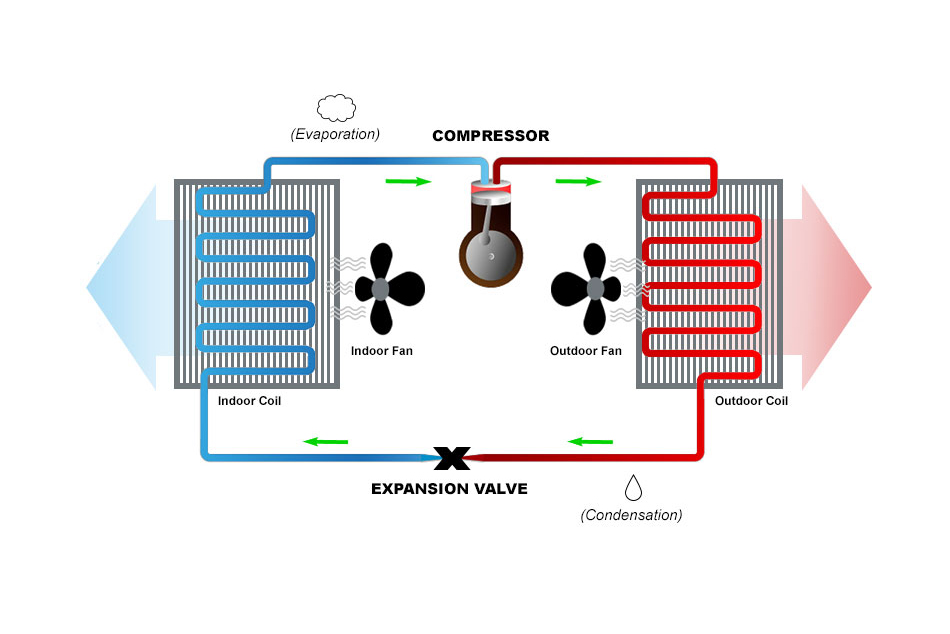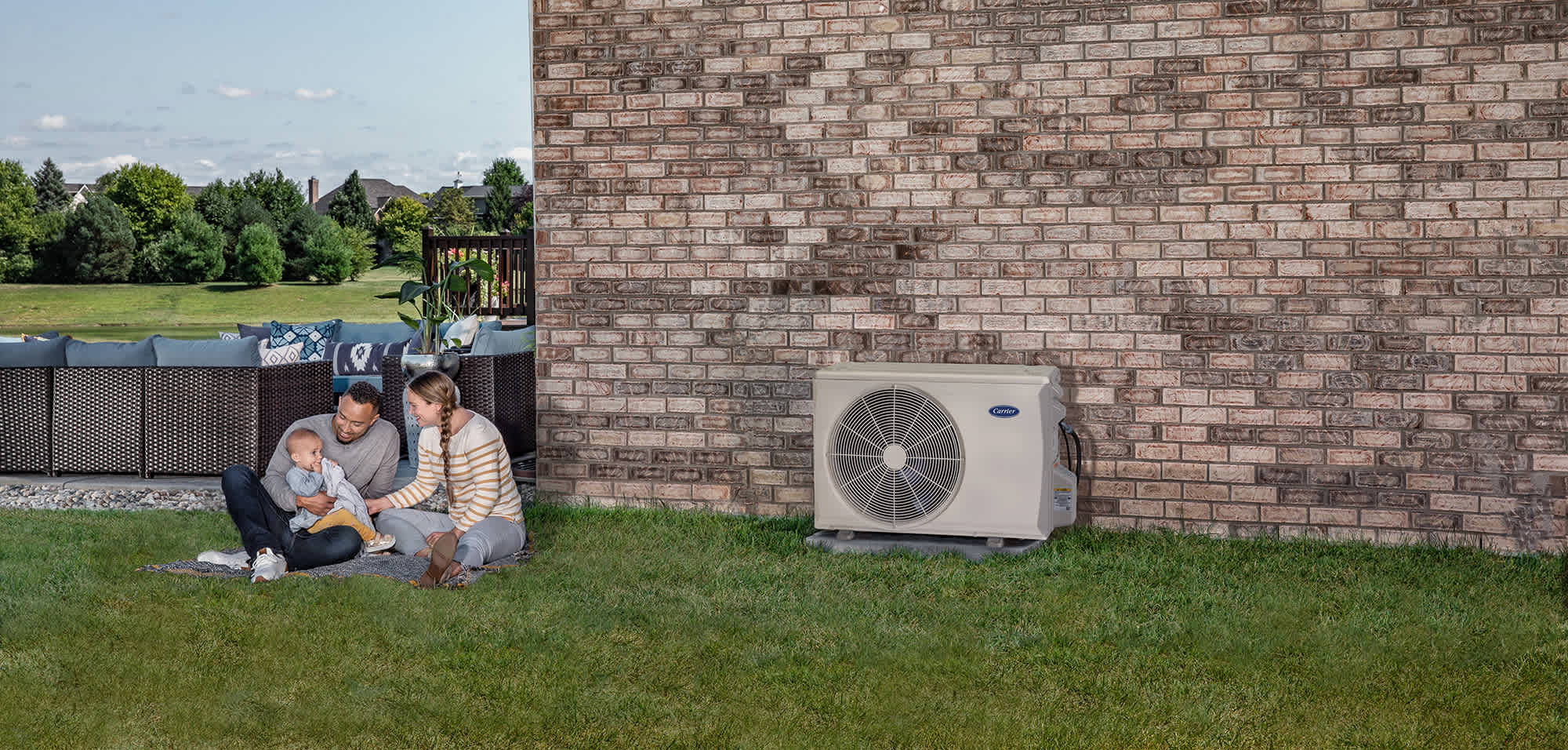Your Guide To Ductless Mini Split Heat Pumps
By Travis Baugh
Most homes in the United States are heated and cooled using a forced air HVAC system such as a natural gas furnace, central air conditioning or an air-source heat pump. This type of heating and cooling system circulates heated or cooled air into living spaces through a series of air ducts which traditional heating are typically hidden behind walls and under floors. But what do you do if you have an older home with no ductwork - or you want to add heating and cooling to a room addition or converted space such as a garage or basement without the hassle and expense of installing ducts? What if your current forced air type of heating system needs a little help? Ductless mini split heat pumps and air conditioners just might be the answer.
With great versatility, easy installation with no ductwork needed, and exceptional energy efficiency with a high SEER2 rating, mini split heat pumps and air conditioners make controlling your home’s temperature a breeze. Available in a variety of sizes and configurations, Carrier ductless AC and mini split systems offer a variety of solutions to your heating and cooling problem. Learn how to determine the proper mini split sizing for your needs.

How Do Mini Split Heat Pumps Work?
So, how do ductless heat pumps work? A ductless heat pump works in much the same way that a standard ducted heat pump works. Both systems require an indoor unit and an outdoor unit. Both systems use a chemical compound called “refrigerant” that circulates between the indoor and outdoor units to help facilitate the heating and cooling process. And, both types of heat pumps can provide heat during the colder months as well as cooling during the hotter times of year.
As the name suggests, ductless mini split heat pumps provide comfort without using traditional ductwork. Ductless heat pumps provide more targeted heating and cooling comfort because heated or cooled air blows directly out of the indoor fan coil unit into the living space. If comfort is needed in multiple rooms, an additional indoor unit will be needed for each area where heating and cooling is needed.

How Does a Mini Split Heat Pump Work? Components Of The System
Answering the question, “how does a mini split heat pump work?” requires taking a closer look at the components of the system. Mini split heat pump systems include an outdoor unit and an indoor unit. Mini split outdoor units house a compressor, condenser coil and expansion valve. Mini split indoor units include a blower fan and evaporator coil. The two units are connected with tubing that allows chemical refrigerant to circulate between the two units. Here’s a closer look at what each of these components do so that you have a better understand how heat pumps work to provide heating or cooling for your living space:
- Refrigerant: Refrigerant circulates in a closed loop through copper tubing, passing between the indoor and outdoor units, where it absorbs heat in its liquid state and releases heat in its gaseous state. The compressor and expansion valve control the temperature and pressure of the refrigerant to facilitate the heating or cooling process.
- Compressor: Located in the outdoor unit, the compressor increases the refrigerant's pressure and temperature to facilitate heat release either outside during cooling or inside during heating. Standard models use a single-speed compressor and higher-efficiency models utilize variable-speed compressors for optimal performance.
- Evaporator Coil: Located in the indoor unit, the evaporator coil absorbs heat and humidity from indoor air using refrigerant flowing through copper or aluminum tubing, which cools the air circulated into the living space. During heating, the process is reversed, with heat absorbed from outdoor air released by the indoor coil to provide comfort indoors.
- Condenser Coil: Located in the outdoor unit of a mini split heat pump, the condenser coil releases heat collected from indoor air during cooling by allowing liquid refrigerant to flow outside. During heating, the process reverses, with heat absorbed from outdoor air, even in cooler temperatures, and released inside to warm the living space.
- Expansion Valve: The expansion valve restricts refrigerant flowing into the evaporator coil, allowing the refrigerant to expand once it enters the coil. The expanding refrigerant causes a drop in pressure, and as a result the temperature drops as well to aid the cooling process.

Pros of Mini Split Heat Pumps
There are many advantages to using ductless mini split heat pumps when compared to their ducted counterparts.
- Energy efficiency: Ductless mini split systems are exceptionally energy efficient especially when compared to typical ducted systems. If you’re looking for a high-performing SEER rating, mini splits can be the answer - high efficiency ductless systems can provide SEER2 ratings (Seasonal Energy Efficiency Ratio) of up to 28.5 during cooling and up to 18 HSPF2 during heating. Many of these models meet the Department of Energy’s ENERGY STAR designation for high efficiency appliances.
- Save money on energy bills: When you combine the exceptional energy efficiency of a mini split heat pump with the savings from only using the system during times the space is being used, you might be surprised with the savings you can see on your energy bills.
- Improved air quality: Because ductless systems do not use ducts to distribute heated or cooled air, they can help minimize the spread of contaminated air from other areas of the home – such as smoke or odors from cooking or fireplaces. And, ductless systems are less likely to collect dust and other pollutants and recirculate them to other parts of the home.
- Installation versatility: Ductless outdoor units are often narrower than typical ducted outdoor units and can be placed in tighter outdoor spaces.
- Boost comfort: Ductless systems add comfort in rooms not attached to your home’s ducted system. They can also provide a comfort boost for rooms a ducted system is struggling to keep properly heated or cooled.

Cons of Mini Split Heat Pumps
We have certainly spent some time building up the advantages of ductless systems for heat pumps and air conditioners. Of course, there are a few disadvantages to consider when making your choice:
- Large up-front investment: In some cases mini split heat pump cost can be a large investement. 1 However, energy savings over time can help make the investment worth it, and if you are trying to add a ducted system where existing ductwork is not already in place, you can expect to pay extra costs that can add up quickly - so in the long run, ductless heating and cooling can help save money over time, making mini split heat pump cost lower than it initially appears.
- Visible indoor unit: Most mini-split indoor units for residential use are mounted on a wall in full view of the room. It’s a less elegant solution than a ducted system which delivers heated or cooled air through vents which are usually flush with the floor, ceiling or wall. The indoor unit for a ducted system is usually hidden in a basement or utility closet or placed out in the garage.
- Indoor unit in each zone or area: To provide comfort in multiple rooms, ductless systems will require an indoor unit for each room. This adds cost, but on the positive side, you can save on energy use by only heating or cooling the room you are using.
- Lower heating/cooling capacity: Ductless heat pumps are typically designed with lower heating or cooling capacities than ducted heat pumps in terms of Btu/h. However, both systems are “sized” by your HVAC contractor to match the needs of the space or home. As long as the ductless mini heat pump is properly sized for the area it is intended, it will provide ample comfort.
How Much Does A Mini Split Heat Pump Cost?
What Is A Good SEER Rating For A Ductless Heat Pump?
Why Choose a Carrier Ductless Mini Split Heat Pump?
When it comes to choosing a ductless mini split heat pump system for your home or room addition, Carrier is here to help. Carrier has been at the forefront of indoor comfort since Willis Carrier invented modern air conditioning in 1902 . Since that time, we have continued to develop new technologies for improving comfort, system efficiency and long-term reliability. With Carrier, you not only get comfort and peace of mind, you get the value that comes with products that are designed to stand the test of time.

As you consider your options, be sure to read up on ductless systems, including how to install a mini split system, and comparisons between a mini split vs central air. Understanding the similarities, differences and installation requirements can go a long way towards helping you decide which system works best for your particular needs.
To see if a ductless mini split heat pump system is right for you, find a Carrier expert.
Check out this article and discover what is Ductless AC
1 https://www.homeadvisor.com/cost/heating-and-cooling/ductless-heat- pump/
Frequently Asked Questions About Heat Pump Mini Splits
Learn More About Mini Split Heat Pumps
- Learn about ductless air conditioner cost
- How big of a mini split do I need?
- How long do mini splits last?
- Can you install a ductless air conditioner for garage?
- Learn about mini split repairs
- Read about mini split maintenance
- How does a heat pump work?
- What is a heat pump vs air conditioner?
- Learn about the different types of ductless heating and cooling system types

